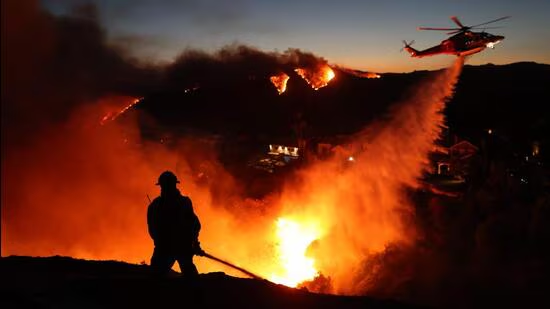Introduction
California has long been synonymous with wildfires, but the California Wildfires 2025 have marked an unprecedented chapter in the state’s history. The state has experienced devastating wildfire seasons in the past, but this year has been particularly catastrophic. With severe drought, rising temperatures, and increased wind activity, the perfect conditions were set for disaster. This article explores the key aspects of the 2025 California wildfires, their impacts, and the lessons that can guide future wildfire prevention and management.
Overview of the 2025 California Wildfires
California’s wildfire California Wildfires 2025 began earlier than usual, with fires sparking as early as January due to dry conditions. By mid-year, over 1.5 million acres had burned across the state. These fires ravaged urban and rural areas alike, resulting in significant loss of life, property, and environmental resources. The wildfires have once again highlighted the state’s vulnerability to the growing threat of climate change.
Major Fires and Affected Areas
The Palisades Fire
The Palisades Fire, one of the largest and deadliest fires of 2025, swept through Los Angeles County, including Pacific Palisades. It destroyed over 2,000 homes and commercial structures, leaving behind a trail of destruction and despair. The fire consumed approximately 150,000 acres and caused widespread evacuations in nearby areas.
The Eaton Fire
The Eaton Fire struck Pasadena and surrounding areas in late February, causing over $4 billion in damage. Despite efforts to contain it, the fire spread rapidly due to high winds, consuming residential neighborhoods and historic landmarks.
The Archer Fire
The Archer Fire, although smaller in scale, affected California Wildfires 2025 communities in the San Fernando Valley. It burned approximately 40,000 acres and underscored the challenges of managing multiple fires simultaneously across the state.
Human Impact
Casualties and Evacuations
The 2025 wildfires claimed more than 50 lives, with hundreds injured in evacuation efforts or by the fires themselves. Over 200,000 residents were forced to flee their homes, many with little notice. Emergency shelters quickly reached capacity, and local authorities struggled to manage the influx of displaced families.
Community Displacement
Entire neighborhoods were reduced to ashes, leaving thousands homeless. The fires have had a lasting psychological impact on survivors, many of whom lost loved ones or cherished belongings. The recovery process for these communities will take years, if not decades.
Economic Consequences
Insurance Industry Challenges
The economic toll of the 2025 wildfires is staggering, with insured losses exceeding $25 billion. Insurance companies have struggled to keep up with claims, and many homeowners in high-risk areas faced skyrocketing premiums or lost coverage altogether.
Uninsured Losses
A significant portion of the losses remains uninsured, particularly in rural areas where residents were unable to afford adequate coverage. Total damages, including uninsured losses, are estimated to surpass $100 billion, making this one of the costliest natural disasters in U.S. history.
Environmental Impact
Air Quality Degradation
The wildfires have severely impacted air quality across California Wildfires 2025 and neighboring states. Smoke and ash have created hazardous conditions, leading to respiratory problems for millions of residents. Schools and businesses were forced to close as air quality indexes reached dangerous levels.
Wildlife and Habitat Loss
California’s diverse ecosystems have suffered immense damage. Thousands of acres of forests and grasslands were destroyed, displacing wildlife and destroying critical habitats. The ecological consequences of these fires will be felt for decades, as the loss of vegetation increases the risk of erosion and disrupts the state’s natural water cycle.
Response and Recovery Efforts
Government Actions
In response to the wildfire crisis, the state and federal governments declared multiple states of emergency. The National Guard was deployed to assist firefighting efforts, and additional resources were allocated for disaster relief and recovery. However, critics argue that more proactive measures, such as investing in fire prevention and infrastructure, are urgently needed.
Community and Volunteer Involvement
Local communities and volunteers played a crucial role in supporting relief efforts. From providing shelter and supplies to raising funds for displaced families, Californians came together to support one another during this time of crisis.
Climate Change and Future Implications
The Role of Climate Change
The 2025 wildfires are a stark reminder of the growing California Wildfires 2025 threat posed by climate change. Rising temperatures, prolonged droughts, and stronger winds have created ideal conditions for wildfires to ignite and spread. Without significant action to address global warming, such disasters are likely to become more frequent and severe.
Preventative Measures
To reduce the risk of future wildfires, California must invest in preventative measures, such as forest management, controlled burns, and community education programs. Enhancing early warning systems and expanding firefighting resources are also critical to minimizing the impact of future fires.
FAQs
1. What caused the 2025 California wildfires?
The wildfires were primarily caused by a combination of California Wildfires 2025 drought, high temperatures, and strong winds, creating ideal conditions for fires to ignite and spread.
2. How many people were affected by the wildfires?
Over 200,000 residents were evacuated, and thousands of homes were destroyed. The fires claimed more than 50 lives and left many communities displaced.
3. What is being done to prevent future wildfires?
Efforts include improving forest management, investing in early warning systems, and addressing climate change through policy and innovation.
4. How much economic damage did the wildfires cause?
Total damages are estimated to exceed $100 billion, including both insured and uninsured losses.
5. What role does climate change play in California’s wildfires?
Climate change has exacerbated the frequency and intensity of wildfires by contributing to prolonged droughts, higher temperatures, and stronger wind patterns.
Conclusion
The California wildfires of 2025 have left an indelible mark on the state’s history, highlighting the urgent need for comprehensive action to address the underlying causes and consequences of these disasters. From improving wildfire prevention and response to tackling the broader issue of climate change, the lessons of 2025 must serve as a catalyst for change. Only through collective effort can California build a more resilient future.





